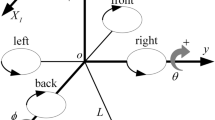Abstract
The control system of parallel robot, especially industrial robot, is a very complex multi-modal nonlinear system, which has the characteristics of time-varying, strong coupling and strong nonlinearity. Trajectory tracking control algorithm is a very important part of industrial robot control system. It is required that the algorithm can realize the continuous tracking of each joint of the robot and the processing and tracking of the desired trajectory. However, due to the strong influence of acceleration and speed on the trajectory tracking of industrial robots, the corresponding control difficulty and control accuracy are seriously affected. Based on the core idea of fuzzy neural network algorithm, the functional relationship between control error and arrival degree is established to improve the control quality of industrial robots. At the same time, combining with the PID feedforward control algorithm, the self-adaptive adjustment of PID parameters is realized, and the accuracy of the tracking algorithm is improved. In order to verify the superiority of the proposed trajectory tracking control algorithm over the traditional PID algorithm, the model of industrial robot is established by using the virtual simulation system Adams. At the same time, the model is simulated by joint experiment. Experimental results show that the trajectory control algorithm based on the proposed trajectory control algorithm is effective. This method has good control accuracy and stability.


















Similar content being viewed by others
References
Agand P, Shoorehdeli MA, Khaki-Sedigh A (2017) Adaptive recurrent neural network with Lyapunov stability learning rules for robot dynamic terms identification. Eng Appl Artif Intell 65:1–11
Ayas MS, Altas IH (2017) Fuzzy logic based adaptive admittance control of a redundantly actuated ankle rehabilitation robot. Control Eng Pract 59:44–54 (Complete)
Belkadi A, Oulhadj H, Touati Y et al (2017) On the robust PID adaptive controller for exoskeletons: a particle swarm optimization based approach. Appl Soft Comput 60:87–100
Chinello F, Malvezzi M, Prattichizzo D et al (2019) A modular wearable finger interface for cutaneous and kinesthetic interaction: control and evaluation. IEEE Trans Ind Electron 99:1
Cui K, Jing X (2018) Research on prediction model of geotechnical parameters based on BP neural network. Neural Comput Appl. https://doi.org/10.1007/s00521-018-3902-6
Dong B, Liu K, Li Y (2017) Decentralized control of harmonic drive based modular robot manipulator using only position measurements: theory and experimental verification. J Intell Robot Syst 88(6):1–16
Freire EO, Rossomando FG, Soria CM (2018) Self-tuning of a neuro-adaptive PID controller for a SCARA robot based on neural network. IEEE Lat Am Trans 16(5):1364–1374
Gao Q, Liu JG, Tian TT et al (2017) Free-flying dynamics and control of an astronaut assistant robot based on fuzzy sliding mode algorithm. Acta Astronaut 138:S0094576516304416
Guo D, Feng X, Yan L (2018) New pseudoinverse-based path-planning scheme with PID characteristic for redundant robot manipulators in the presence of noise. IEEE Trans Control Syst Technol 26(6):2008–2019
Kai L, Xu J, Ge Z et al (2017) Robust control of 3-DOF parallel robot driven by PMAs based on nominal stiffness model. Adv Robot 31(10):1–13
Kumar A, Kumar V (2017) Evolving an interval type-2 fuzzy PID controller for the redundant robotic manipulator. Expert Syst Appl 73:161–177 (Complete)
Lopezfranco C, Gomezavila J, Alanis A et al (2017) Visual servoing for an autonomous hexarotor using a neural network based PID controller. Sensors 17(8):1865
Mushage BO, Chedjou JC, Kyamakya K (2017) Fuzzy neural network and observer-based fault-tolerant adaptive nonlinear control of uncertain 5-DOF upper-limb exoskeleton robot for passive rehabilitation. Nonlinear Dyn 87(3):2021–2037
Oh JS, Sohn J, Choi SB (2018) Material characterization of hardening soft sponge featuring MR fluid and application of 6-DOF MR haptic master for robot-assisted surgery. Materials 11(8):1268
Pachauri N, Singh V, Rani A (2017) Two degree of freedom PID based inferential control of continuous bioreactor for ethanol production. ISA Trans 68:235–250
Palpacelli M, Palmieri G, Carbonari L et al (2017) Sensitivity analysis and model validation of a 2-DoF mini spherical robot. J Intell Robot Syst 6:1–9
Pan Y, Xiang L, Yu H (2018) Efficient PID tracking control of robotic manipulators driven by compliant actuators. IEEE Trans Control Syst Technol 99:1–8
Perng JW, Chen GY, Hsu YW (2017) FOPID controller optimization based on SIWPSO-RBFNN algorithm for fractional-order time delay systems. Soft Comput 21(14):4005–4018
Sarkar A, Dutta A (2019) Optimal trajectory generation and design of an 8-DoF compliant biped robot for walk on inclined ground. J Intell Robot Syst 94(3–4):583–602
Siddiqui MR, Ahmad SM, Asghar U (2017) Stabilizing control of a 1-DOF electromagnetic levitation of pivoted-free rigid ferromagnetic beam. Measurement 106:35–45
Srivastava S, Pandit VS (2017) A 2-Dof LQR based PID controller for integrating processes considering robustness/performance tradeoff. ISA Trans 71(Pt 2):426
Sun Y, Xu J, Qiang H et al (2019) Adaptive neural-fuzzy robust position control scheme for Maglev train systems with experimental verification. IEEE Trans Ind Electron 66(11):8589–8599
Xia W, Zhao J (2017) Autonomous switched control of load shifting robot manipulators. IEEE Trans Ind Electron 64(9):7161–7170
Yang C, Zhao J, Li L et al (2018) Design and implementation of a novel modal space active force control concept for spatial multi-DOF parallel robotic manipulators actuated by electrical actuators. ISA Trans 72:273
Ye C, Song Y (2018) Adaptive PID-like fault-tolerant control for robot manipulators with given performance specifications. Int J Control 4:1–22
Yin X, Li P (2018) Enhancing trajectory tracking accuracy for industrial robot with robust adaptive control. Robot Comput Integr Manuf 51:97–102
Yin X, Pan L (2018) Direct adaptive robust tracking control for 6 DOF industrial robot with enhanced accuracy. ISA Trans 72:178
Acknowledgements
This work is supported by the scientific research project of Education Department in 2017 (No.:18B460019, No.: 2017SJGLX136); the scientific research project of department of Science and Technology in 2018 (No.: 182102210553).
Author information
Authors and Affiliations
Corresponding author
Additional information
Publisher's Note
Springer Nature remains neutral with regard to jurisdictional claims in published maps and institutional affiliations.
Rights and permissions
About this article
Cite this article
Wang, J., Zhu, Y., Qi, R. et al. Adaptive PID control of multi-DOF industrial robot based on neural network. J Ambient Intell Human Comput 11, 6249–6260 (2020). https://doi.org/10.1007/s12652-020-01693-w
Received:
Accepted:
Published:
Issue Date:
DOI: https://doi.org/10.1007/s12652-020-01693-w




